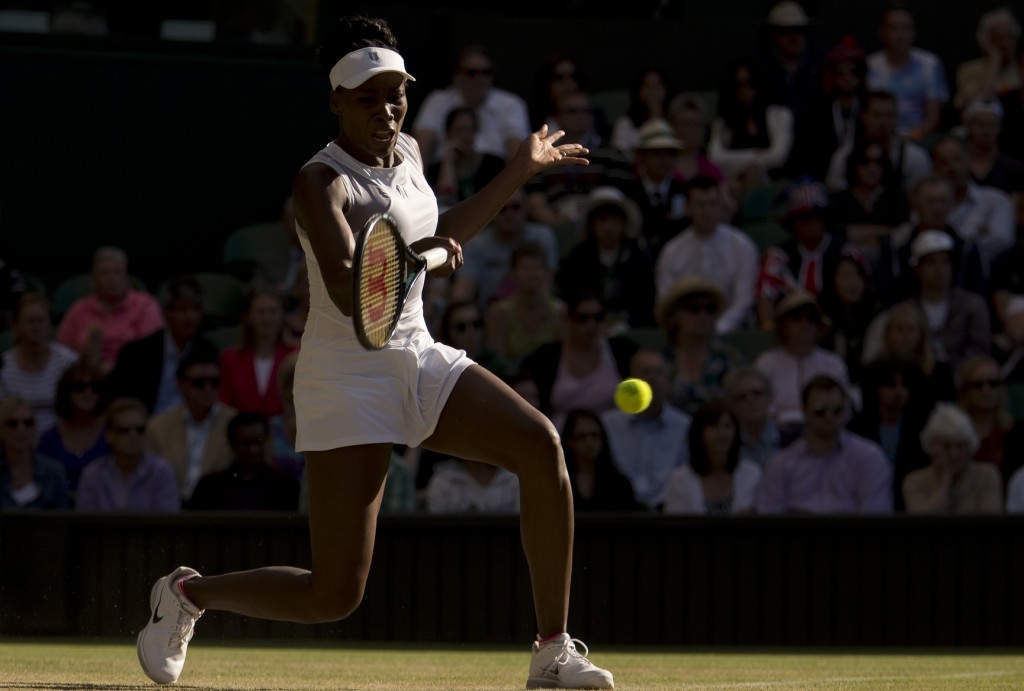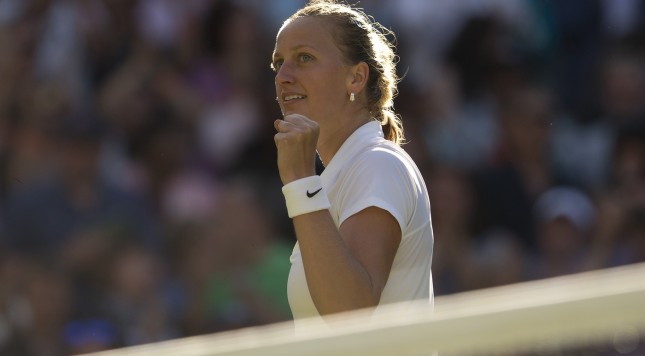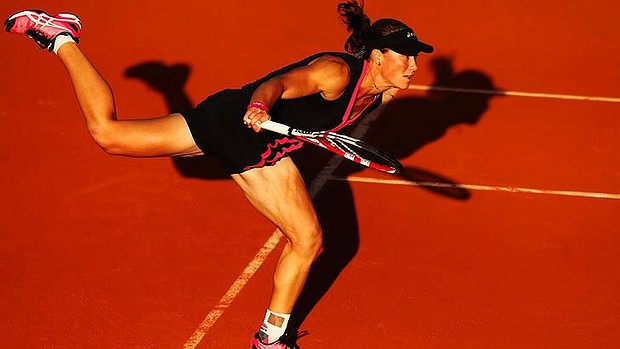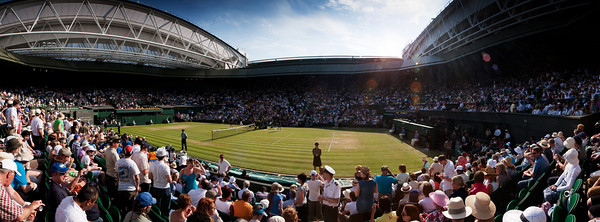Look at the photo of Petra Kvitova.
Notice the background of shade, contrasting with the ribbon of golden light on the top of Kvitova’s head. That’s the kind of camera shot that can be found at Centre Court Wimbledon during the five o’clock hour on a sunny summer afternoon. During that particular part of a late-June or early-July day at the All-England Lawn Tennis and Croquet Club, the high sun of early afternoon gives way to a slanting sun, which turns the world’s most famous tennis arena into an artist’s ultimate canvas.
The best visuals in tennis come from two sources. One is this, seen a few weeks ago in Paris at Roland Garros:
The other is this, at Centre Court, and it’s essentially the image seen on Friday, when Kvitova and Venus Williams engaged each other in a third-round match that everyone in the global tennis community was eager to see:
When human beings witness something great, they might be inspired to say, “That was (tennis, basketball, music, poetry) from the gods.” In order to give women’s tennis due praise, Kvitova and Venus produced tennis from the goddesses on Friday. Yes, this wasn’t the best tennis match you’ve ever seen — it took awhile to get going, with both players trying to find the range on their shots in a solid but not spectacular first set. Yet, by the time this slugfest was over, it earned the right to be viewed as legitimately great.
Through three full-length sets, these accomplished players — both Wimbledon champions, adding to the weight of the moment — allowed only three break points to each other (2 allowed by Venus, 1 by Kvitova). It was something you don’t often see in women’s tennis: Two players forcefully took care of their serves, regularly producing an ace, service winner, or leverage-granting first ball when facing 0-30, 15-30, and 30-all points. That’s how break points are avoided, and that’s why the match acquired a 5-7, 7-6 (2), 7-5 scoreline, with Kvitova finding a way to prevail.
It is true that the mere presence of many service breaks does not inherently make any tennis match worse than another. Just look at a John Isner or Ivo Karlovic match (substitute other names accordingly) to appreciate this particular point. Many matches feature stacks of easy service holds, multiple tiebreakers… and are dull as watching paint dry. Two servebots with mediocre return games and below-average groundstrokes turn tennis into a very monotonous parade, back and forth along the baseline. 15-love. 30-love. 40-love. Game.
Yet, if women’s tennis does at times suffer, it occasionally involves matches or tournaments in which players prone to serving double faults (Maria Sharapova) or slow second serves (Sara Errani) aren’t punished for their manifest deficiencies. That’s when the quality of a match decreases in relationship to the level of serving on display. The serve is the foundational shot in tennis, at least to the extent that the shot initiates each point. In a high-level match, there should be at least some degree of performance art when it comes to toeing the white line and hitting a stationary shot under immense scoreboard pressure.
On Friday, Venus Williams — five times the winner of Wimbledon — matched Kvitova, the 2011 champion, in a duel characterized by this exact form of excellence. This wasn’t an Isnerian or Karlovician snoozefest — it became something so much more than that. Venus and Kvitova played a match in which a few core truths were established and then affirmed:
A) The inability to make first serves consistently led to more precarious positions in points for the server.
B) The ability to make first serves, particularly with great placement in the service box (but also with respect to body serves), regularly gave the server the upper hand.
C) Successful attempts to hit close to the lines were rewarded more often than not.
What one can derive from the characteristics of Venus-Kvitova is that the two women played first-strike tennis. Neither player rolled the ball back the way you might see on a clay court. Neither woman felt the need to settle into a rally on many occasions, which you might sometimes see on a medium-pace hardcourt. On grass, the low, skidding bounces of the ball — made more precarious by the worn-out area near the baseline — recommend a more aggressive style to players. Those who fail to take the initiative on grass are lost, and that’s why the surface has always been conducive to shotmaking.
Whereas clay-court tennis is more likely to reward the player who tries to win a point by extending it, grass — albeit not to the extent found in the 1980s or prior decades — is still the surface where players can thrive by trying to win points with the smallest number of strokes. Grass is the “get to the point” surface in the sport. When a serve and a missed return are the only shots you ever see during a match, the whole affair can be boring, but when clutch serves coexist with quick, bracing, bang-bang rallies that involve very few “get-acquainted” exchanges, the level of entertainment soars through the roof.
That’s what was seen — and, revealingly, sustained — in this clash of champions, one a legend of the sport (Venus) and the other a talented 24-year-old who is trying to find the consistency that can vault her career to a new plateau (Kvitova).
There were no half-pace rally balls leisurely traded for five or six shots, in a spirit of “warming up and finding rhythm.” Virtually every stroke unleashed by these women sought to do some damage. The majority of shots in this match were pummeled with a maximum of pace, but both players did try to slice and hit off-pace shots at times — not to prolong a point, but to force the opponent to bend or squat and perhaps offer up a short ball in the process. Grass is indeed the surface on which a low, knifing slice — if executed well — is an especially weaponized shot and not merely a way of trying to buy time as a defender. Whatever Venus and Kvitova did on Friday, they did to win a point as quickly as they could. Their shared ability to pull off this risky style of tennis in three sets which all reached the maximum length of 12 normal service games (the second set adding the tiebreaker) offers a glimpse into the heights they reached on Centre Court.
*
The foremost memory of this match will be that it was illuminated not just by the light of that dramatic late-afternoon sun in England, but by the brightness of tennis on display. Two champions at the All-England Club arrived at this match without recent results to point to, without present-day accomplishments that could suggest a renaissance in either player’s career. Venus hadn’t won Wimbledon in six years, Kvitova in three. The successes of each player at SW19 were memories more than indicators of present-day prospects. Yet, when this match had ended, the older Williams sister and her younger Czech opponent had both done something to add to their achievements in tennis.

Venus Williams played magnificently on Friday afternoon. She silenced the chorus of critics who think she should have retired a long time ago. She rewarded her own love of tennis with a poignant display of resilience. She grew in stature… and she was the losing player.
Due to health issues, Venus Williams has — over the past few years — often looked like a player with a slim-to-nonexistent chance of making the second weeks at major tournaments. This is the simple, inescapable reality of approaching your mid-30s as a tennis professional. Kvitova, on the other hand, came into this match from a different vantage point. Still on the sunshine side of 25 but plagued by nicks, bruises, and allergies, Kvitova remained in search of the elusive ability to maintain a high level of play in both individual matches and whole tournaments. When tennis fans saw this match as a possibility following the release of the Wimbledon draw a week ago (on June 20), they were excited, but not because they were expecting a match worthy of a major semifinal. Fans across the globe just wanted to see two Wimbledon champions go at it on Centre Court and provide a number of memorable points. The combination of Venus’s age and Kvitova’s maddening inconsistency made plenty of observers cautious about expecting too much from this third-round encounter. A great match between the two was hoped for, but not quite expected.
It is that bit of background which magnifies what Venus Williams and Petra Kvitova achieved.
Venus, despite her age, showed that she could still compete on the big stage and keep pace with a much younger player who performed extremely well for the duration of the proceedings. Had Venus won this match in the second-set tiebreaker or at 6-4 in the third set, the result would not have been the product of Kvitova’s failures. Venus put herself in position to win this match with one of her finest displays in many years, one which recalled each of her five championships inside the cathedral of tennis. Her level of stature in tennis — for on-court achievements but also for leading the fight to bring about equal prize money at Wimbledon — is immeasurably high. Yet, Venus Ebony Starr Williams grew a little more by unfurling this particular masterwork of a match on Friday.
And she was the losing player.
Improbably yet unmistakably, Petra Kvitova — so routinely prone to blips, slips, yips, and mental trips of all kinds — held her nerve and serve in the face of Venus’s quality and pressure. Down a set and 2-3, love-30, in the second set, Kvitova uncorked four strong points to hold and get to 3-3. Down 4-5, 15-30, and just two points from defeat later in the second set, the Czech didn’t blink, calling upon her thunderous serves and groundstrokes to steer out of trouble. Kvitova played an airtight tiebreaker to earn the chance at a third set and a victory, and in the early stages of the third, she was carrying the run of play. However, Venus redoubled her own efforts to help this contest become the mighty and magnificent struggle it turned out to be. At 4-4, Kvitova fell behind love-30 once more. Venus, not faltering in a third set as has happened plenty of times in her “old woman” years, looked to be the picture of confidence as she waited for Kvitova to serve.
So many times in 2012, 2013, and on into 2014, Kvitova would have flinched in such a situation. She memorably lost a tight third set to Maria Sharapova (the same player she defeated in the 2011 Wimbledon final) in the semifinals of the 2012 Australian Open, a match which eroded her confidence and in many ways enabled Sharapova to become the third-best player on the WTA Tour after Serena Williams and Victoria Azarenka. Kvitova, like Li Na (who was knocked out of Wimbledon on Friday by Barbora Zahlavova Strycova in two tiebreaker sets), had become a player known for reaching extreme heights but being unable to remain on the mountaintop for very long. When she arrived at yet another love-30 crisis point at 4-4 in the third, it was entirely reasonable to think, “This will be the challenge Kvitova can’t conquer.”
Yet, the longstanding narrative attached to Kvitova was refuted this time around.
Armed with a level of clarity that has been conspicuous by its relative absence for most of the past three years, Kvitova held for 5-4 and substantially changed the energy on the court. Venus — so close to being able to serve for the match on a day when she hadn’t been broken — watched an opportunity slip away thanks to her opponent’s convincing response. After the two players traded holds once again for 6-5, Kvitova benefited from a few errors by Venus to earn just her second break point of the afternoon. She promptly converted it with one more authoritative point. In one afternoon, Kvitova went from “dangerous floater with an outside chance at Wimbledon” to “legitimate threat for Wimbledon if she continues to play this well.”
Venus Williams showed that she still has magic left in her serve, her groundstrokes, and her ability to compete at the highest levels of tennis.
Petra Kvitova showed that she can make pressure her friend and not her enemy, doing something not often seen since she put the rest of the WTA at her feet three long years ago at the All-England Club.
A luminous display of tennis, bathed in late-afternoon light in tennis’s greatest arena?
Venus v. Kvitova really was a match from the goddesses.



